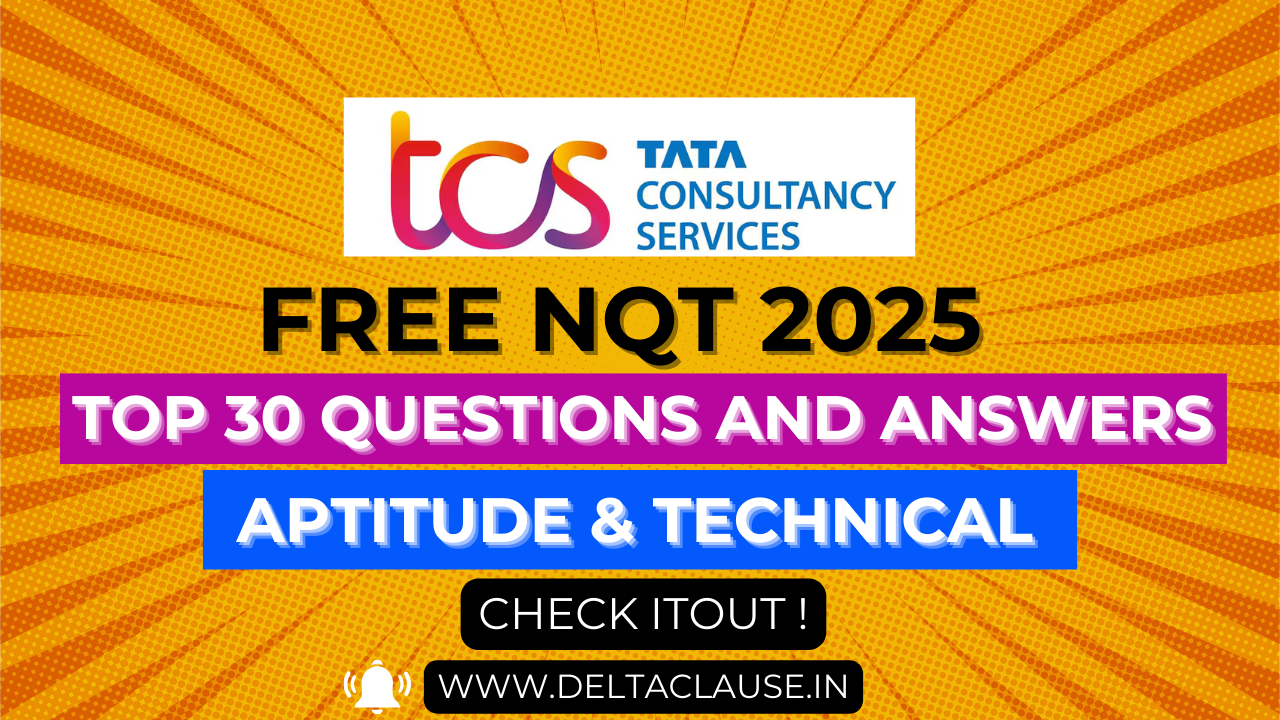Introduction
TCS National Qualifier Test (TCS NQT) is a gateway for freshers to secure a job in Tata Consultancy Services (TCS). It evaluates candidates on aptitude, technical skills, and programming ability. Preparing for TCS NQT requires a strong grasp of fundamental concepts in quantitative aptitude, logical reasoning, verbal ability, and programming. To help you ace the exam, we have compiled 30 important TCS NQT questions and answers covering both Aptitude and Technical topics. Let’s dive in!
Aptitude Questions
1. Number Series
Q1: Find the next term in the series: 2, 6, 12, 20, 30, ?
A: The pattern follows n(n+1). Next term = 6(7) = 42
2. Time & Work
Q2: A and B together can complete a task in 6 days. A alone can complete it in 10 days. How long will B take alone?
A: Work done by A in 1 day = 1/10, Work done by A+B in 1 day = 1/6 1/6 – 1/10 = 1/15. B alone will take 15 days.
3. Probability
Q3: A bag contains 5 red, 4 green, and 6 blue balls. A ball is drawn randomly. Find the probability of drawing a green ball.
A: Total balls = 5 + 4 + 6 = 15 Probability = 4/15
4. Permutations & Combinations
Q4: In how many ways can the letters of the word “APPLE” be arranged?
A: Since ‘P’ appears twice, the formula is 5!/2! = 60
5. Profit & Loss
Q5: A product is sold for Rs. 960 with a loss of 20%. What was the cost price?
A: Cost Price = Selling Price / (1 – Loss%) 960 / 0.8 = Rs. 1200
6. Speed, Distance & Time
Q6: A train 150 m long crosses a pole in 10 seconds. Find its speed in km/hr.
A: Speed = Distance / Time = 150 / 10 = 15 m/s = 54 km/hr
7. Simple Interest
Q7: Find the simple interest on Rs. 5000 for 2 years at an annual rate of 5%.
A: SI = (P × R × T) / 100 = (5000 × 5 × 2) / 100 = Rs. 500
8. Data Interpretation
Q8: If the pie chart shows that 40% of students like Mathematics, and there are 200 students, how many like Mathematics?
A: (40/100) × 200 = 80 students
9. Logical Reasoning – Blood Relation
Q9: A is the brother of B. B is the son of C. How is A related to C?
A: A is also the son of C.
10. Coding-Decoding
Q10: If “APPLE” is written as “ZKOOX” in a certain code, how will “ORANGE” be written?
A: Each letter is shifted backward by one: ORANGE → NQZMFD
Technical Questions
11. C Programming
Q11: What is the output of the following code?
#include<stdio.h>
int main() {
int a = 5;
printf("%d", a++);
return 0;
}
A: Output: 5 (Post-increment prints before increasing the value).
12. Data Structures – Stack
Q12: What is the time complexity of push and pop operations in a stack?
A: O(1) for both push and pop operations.
13. Sorting Algorithms
Q13: Which sorting algorithm has the worst-case time complexity of O(n²)?
A: Bubble Sort, Selection Sort, and Insertion Sort.
14. DBMS – Normalization
Q14: What is the purpose of normalization in a database?
A: To reduce redundancy and avoid anomalies by dividing data into multiple related tables.
15. SQL Query
Q15: Write an SQL query to retrieve all employees earning more than Rs. 50000.
A: SELECT * FROM Employees WHERE Salary > 50000;
16. Operating Systems
Q16: What is a deadlock in an OS?
A: A state where multiple processes wait indefinitely for resources held by each other.
17. Computer Networks
Q17: What is the difference between TCP and UDP?
A: TCP is connection-oriented, reliable, and ensures data integrity. UDP is connectionless and faster but less reliable.
18. OOPS Concept
Q18: Define polymorphism.
A: Polymorphism allows the same function to have different meanings in different contexts (method overloading and overriding).
19. Java – Exception Handling
Q19: What is the difference between throw and throws?
A: throw is used to manually throw an exception, while throws is used to declare exceptions in a method signature.
20. Data Structures – Linked List
Q20: What is the advantage of a linked list over an array?
A: Dynamic size, efficient insertions/deletions, and no memory wastage.
21. Python – List vs Tuple
Q21: What is the difference between a list and a tuple in Python?
A: Lists are mutable, while tuples are immutable.
22. Cloud Computing
Q22: What are the three main cloud service models?
A: IaaS, PaaS, SaaS (Infrastructure as a Service, Platform as a Service, Software as a Service).
23. Software Development Models
Q23: What is the Agile model?
A: A flexible, iterative development approach focusing on collaboration and continuous improvement.
24. Cybersecurity
Q24: What is SQL Injection?
A: A hacking technique where attackers manipulate SQL queries to gain unauthorized access to a database.
25. AI & Machine Learning
Q25: What is supervised learning?
A: A type of ML where the model is trained on labeled data.
26. JavaScript – Closures
Q26: What is a closure in JavaScript?
A: A function that retains access to its parent scope even after the parent function has executed.
27. Git & Version Control
Q27: What does git pull do?
A: It fetches and merges remote repository changes into the local branch.
28. Big Data
Q28: What is Hadoop?
A: An open-source framework for processing large datasets across distributed systems.
29. Linux Commands
Q29: What does the grep command do?
A: Searches for patterns in files.
30. Web Development
Q30: What is REST API?
A: A web service that follows REST principles using HTTP methods like GET, POST, PUT, and DELETE.
Final Words of Encouragement
Preparing for TCS NQT requires consistency and a strategic approach. Focus on core concepts, practice regularly, and take mock tests. Stay confident, and don’t hesitate to clear your doubts. Believe in yourself, and success will follow! Good luck!
